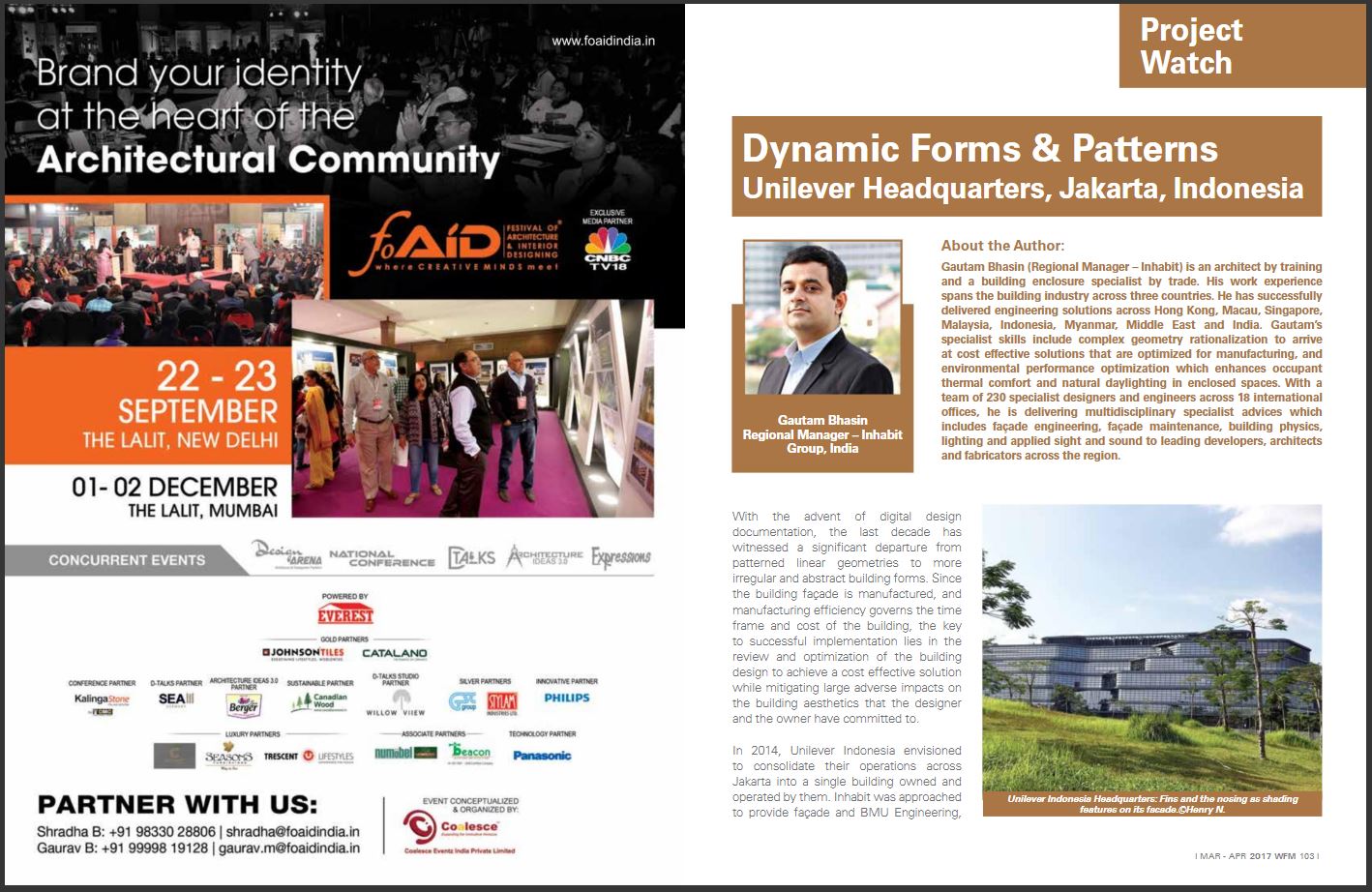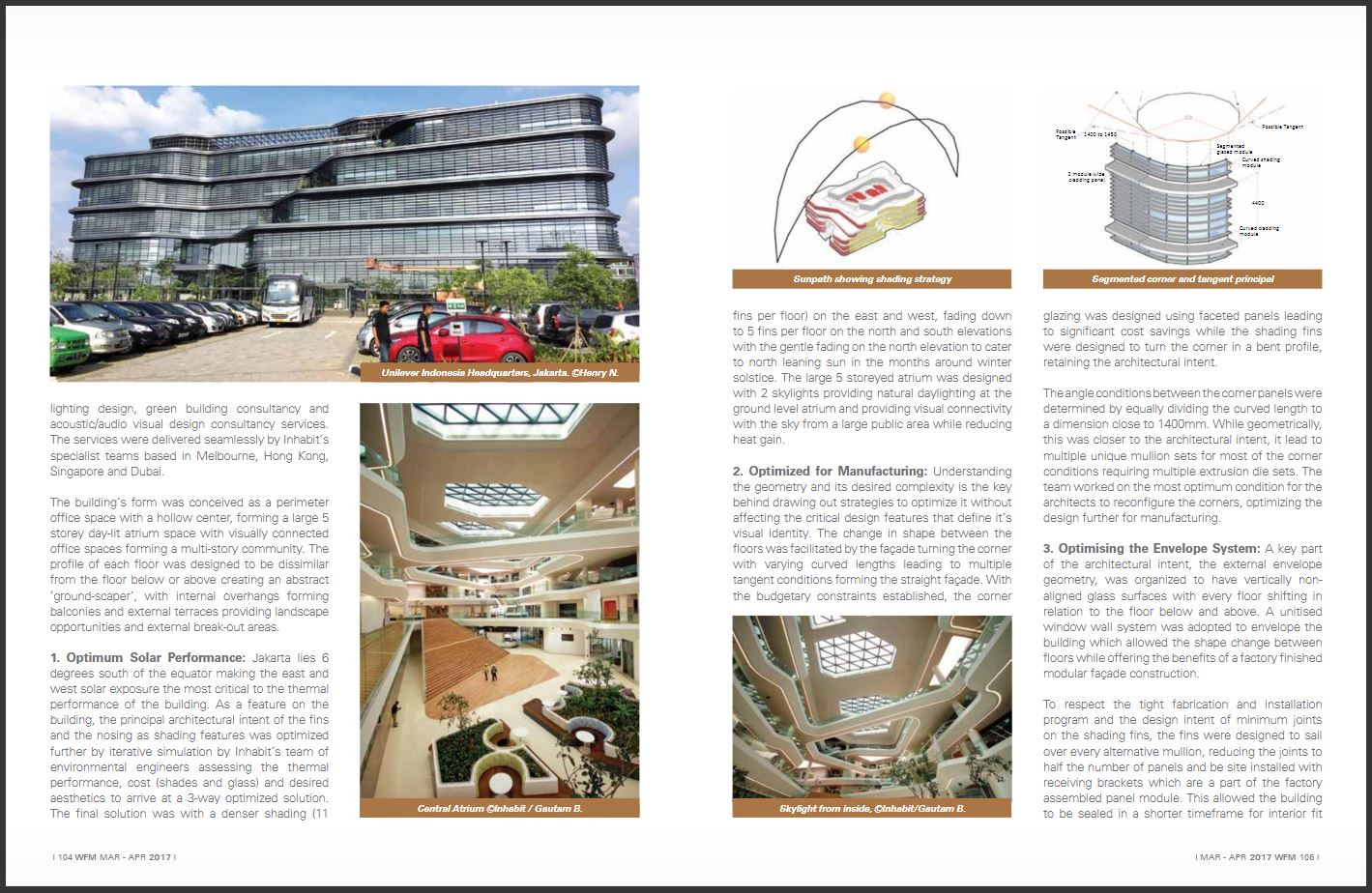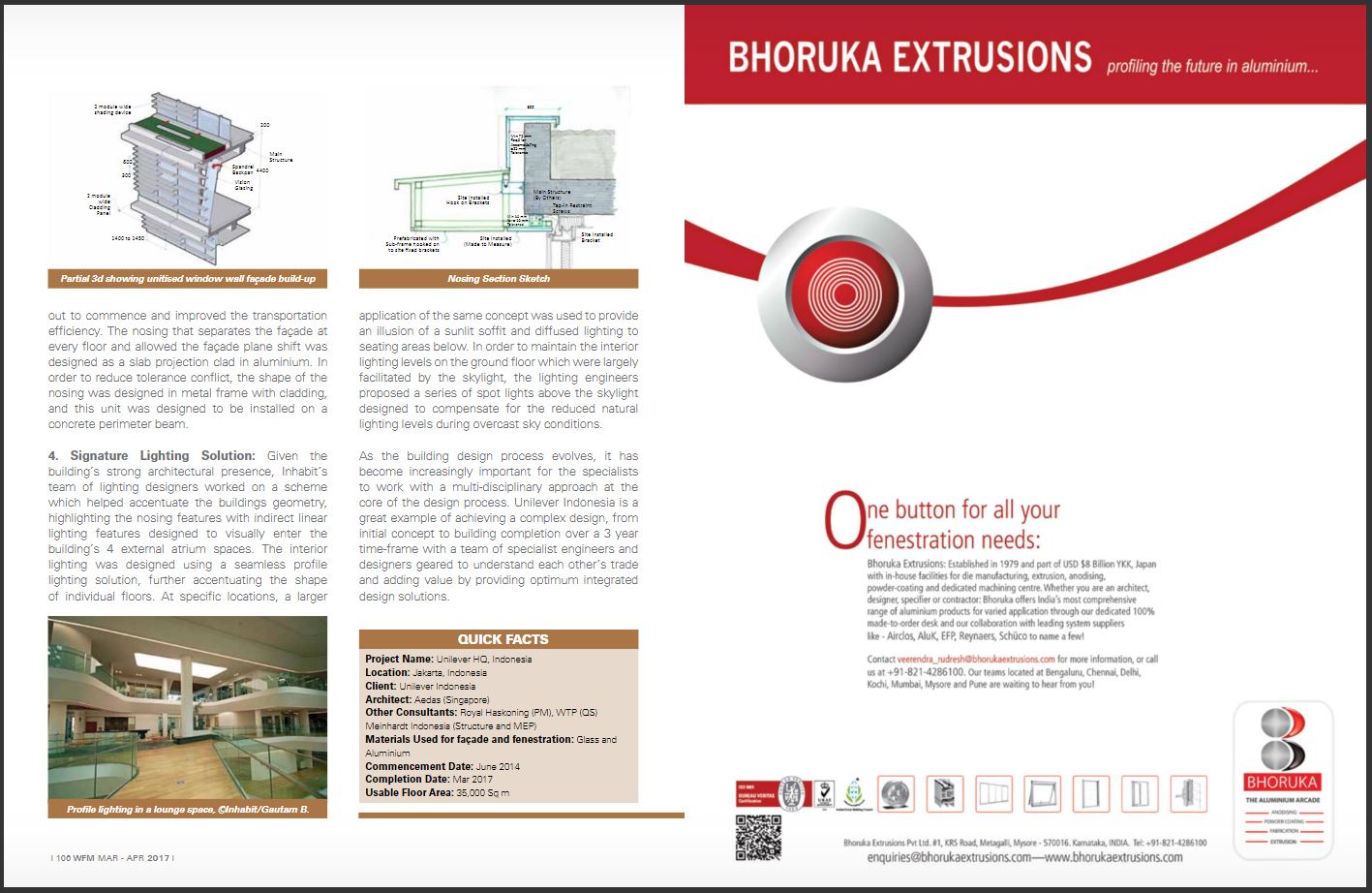Project Watch – Unilever Indonesia Headquarters, Jakarta
Jakarta, Indonesia:
Inhabit’s project ‘Unilever’ has been featured in the ‘WF Magazine’ publication. The article ‘Dynamic Forms & Patterns – Unilever Headquarters, Jakarta, Indonesia’ looks at the design approach used to resolve a complex façade solution with effective multidisciplinary inputs from the key Inhabit offices. Inhabit successfully delivered this project from their Singapore (Façade and BMU), Hong Kong (Lighting), Melbourne (Green Mark), Jakarta (Site support) and Dubai (Acoustics) offices.
The magazine can be viewed via the link or please find the publication text below.
https://issuu.com/wfm-india/docs/wfm_magazine_vol._3_issue_5
Project Watch – Unilever Indonesia Headquarters, Jakarta
With the advent of digital design documentation, the last decade has witnessed a significant departure from patterned linear geometries to more irregular, abstract building forms. Since the building façade is manufactured and manufacturing efficiency, in large part, governs the time frame and cost of the building, the key to successful implementation lies in the review and optimisation of the building design to achieve a cost effective solution while mitigating large adverse impacts on the building aesthetics to which the designer and the owner have committed.
In 2014, Unilever Indonesia envisioned to consolidate their operations across Jakarta into a single building owned and operated by them. Inhabit was approached to provide Façade and BMU Engineering, Lighting Design, Green Building Consultancy and Acoustic Design consultancy services. The services were delivered seamlessly by Inhabit’s specialist teams based in Melbourne, Hong Kong, Singapore and Dubai.
The building form was conceived as a perimeter office space with a hollow centre forming a large 5 storey, day lit atrium space with visually connected office spaces, creating a multi-storey community. The floor plates are designed to either cantilever over or recess from the floor above/below, forming a shape shifting ‘ground-scraper’ with internal balcony overhangs and external terraces providing landscape opportunities and external break-out areas.
1.Optimum Solar Performance: Jakarta lies 6 degrees south of the equator making the east and west solar exposure the most critical to the thermal performance of the building. As a feature of the building, the principal architectural intent of the fins and the nosing as shading elements was further optimised by iterative simulation by Inhabit’s team of environmental engineers, assessing the thermal performance, cost (shades and glass) and desired aesthetics to arrive at a 3-way optimised solution. The final solution provides denser shading (11 fins per floor) on the east and west reducing to 5 fins per floor on the north and south elevations with gentle fading on the north elevation to cater for north leaning sun in the months around winter solstice. The large 5 storey atrium was designed with 2 skylights providing natural daylight at the ground level atrium and a visual connectivity with the sky from the large public area.
2.Optimised for Manufacturing : Understanding the geometry and its desired complexity is the key behind drawing out strategies to optimise it without affecting the critical design features that define its visual identity. The change in shape between floors was facilitated by the façade turning the corner with varying curved lengths leading to multiple tangent conditions forming the straight façade. With the budgetary constraints established, the corner glazing was designed using faceted panels which led to significant cost savings, while the shading fins were designed to turn the corner in a bent profile retaining the architectural intent.
The angle conditions between the corner panels were determined by equally dividing the curved length to a dimension close to 1400mm. While geometrically, this was closer to the architectural intent, it lead to multiple unique mullion sets for most of the corner conditions requiring multiple extrusion die sets. The team worked on the most optimum condition for the architects to reconfigure the corners, further optimising the design for manufacturing.
3.Optimising the Envelope System : As a key part of the architectural intent, the external envelope geometry was organised to have vertically non-aligned glass surfaces with every floor shifting in relation to the floor above and below. A unitised window wall system was adopted to envelope the building, thus allowing the shape change between floors whilst also offering the benefits of factory finished modular façade construction.
To respect the tight fabrication and installation program and the design intent of minimum joints, the shading fins were designed to oversail every alternate mullion reducing the joints by half and allowing site installation of receiving brackets which are part of the factory assembled panel module. This allowed the building to be sealed within a shorter timeframe, the interior fit-out to commence and also improved the transportation efficiency. The nosing that separates the façade at every floor and allows the façade plane shift was designed as a slab projection to be clad in aluminium. In order to reduce tolerance conflict, the shape of the nosing was designed in metal frame with cladding, and this unit was designed to be installed on a concrete perimeter beam.
4.Signature Lighting Solution:Given the building’s strong architectural presence, Inhabit’s team of lighting designers developeda scheme that accentuates the building’s geometry, highlighting the nosing features with indirect linear lighting features, designed to visually enter the building’s 4 external atrium spaces. The interior lighting has been designed using a seamless profile solution, further accentuating the shape of the individual floors. At specific locations, a larger application of the same concept is used to provide an illusion of a sunlit soffit and diffused lighting to seating areas below. In order to maintain the interior illumination levels on the ground floor, which were largely facilitated by the skylight, the lighting engineers proposed a series of spot lights above the skylight designed to compensate for any reduction in natural light during overcast sky conditions.
As the building design process has evolved, it has become increasingly important for the specialists at the core of the design process to work with a multi-disciplinary approach. Unilever Indonesia is a great example of achieving a complex design, from concept to completion, within 3 years with a team of specialist engineers and designers geared to understand each other’s trade and adding value by providing optimum design solutions.


